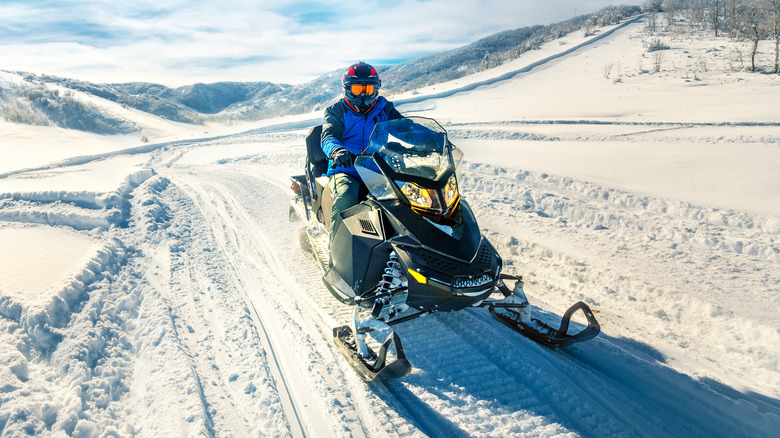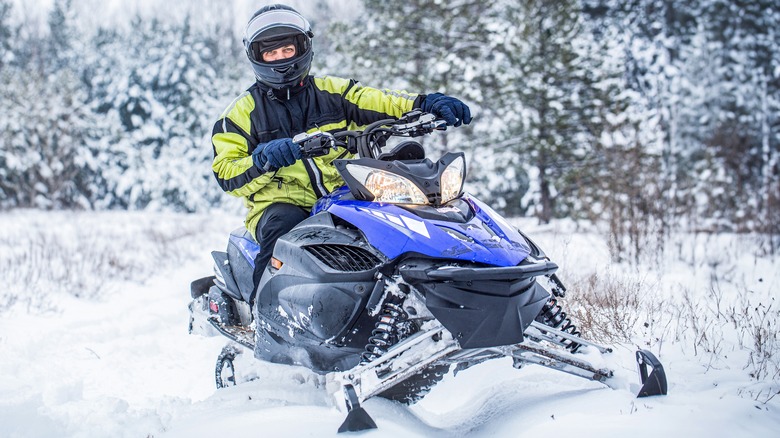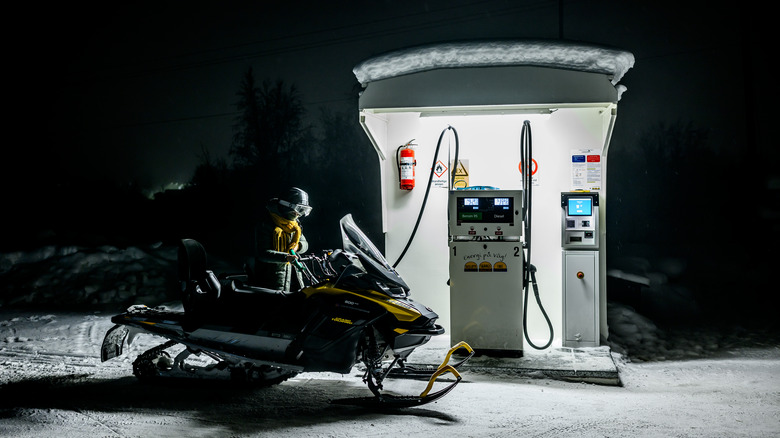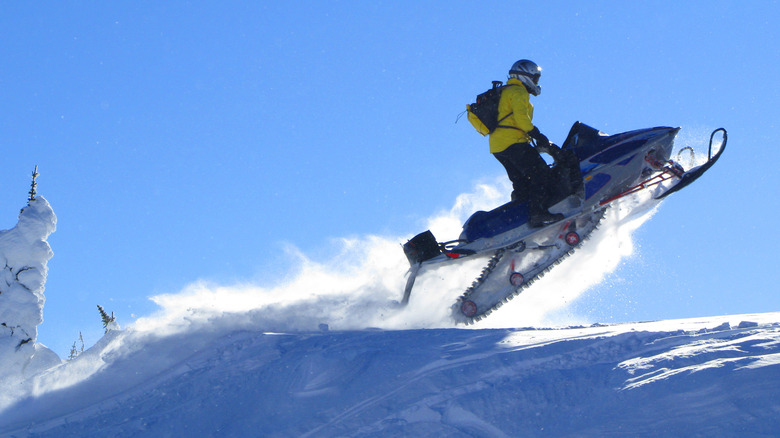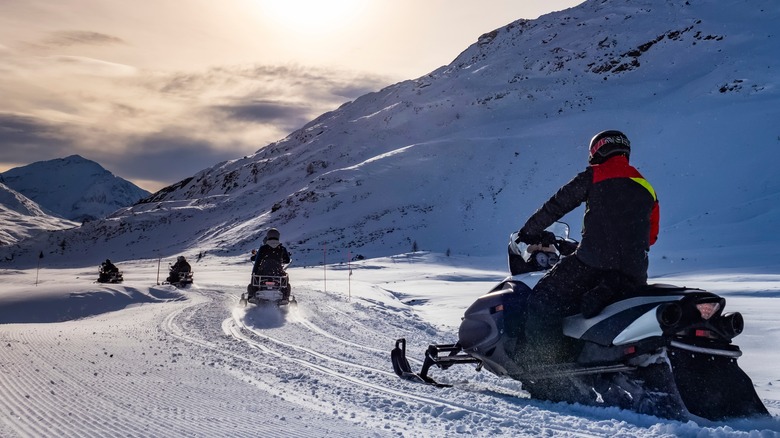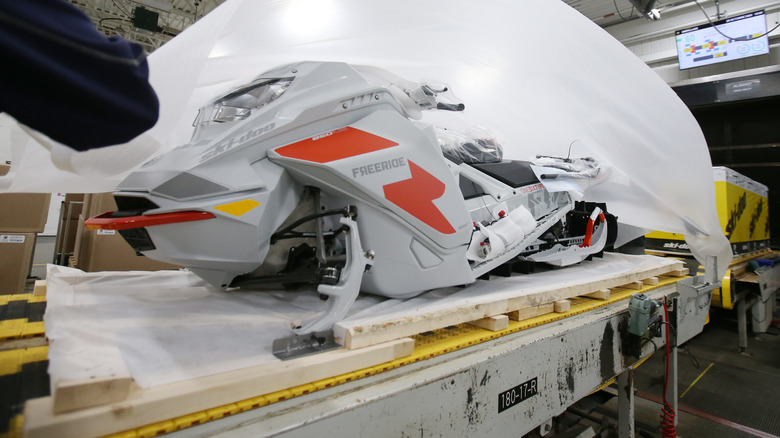5 Snowmobile Riding Tips For Beginners
A snowmobile, in comparison to other vehicles, is generally far less mechanically complex from a dashboard point of view. For many, they're just a novelty, a fun vacation activity, but there's actually a lot more to snowmobiles than that. In fact, as inviting and user-friendly as they might appear to be, there are certain things newcomers will need to bear in mind before riding one.
For example, there are the legal considerations that come with tearing through the snow, and there's also the specialized gear you'll need to wear before hopping on your ride. With such a wide range of different snowmobile experiences to enjoy, it's also important to pick one that can help you build your confidence. Immediately biting off more than you can chew is a sure way to sour yourself on a new experience, so let's take a look at some beginner tips for these unique vehicles.
Make sure you're kitted out before you begin
For most drivers, there isn't really much of a dress code to speak of. If you have to hurry out to the ATM, the T-shirt and jeans you happen to be wearing at the time will generally be just fine, barring extremes of weather you might need to wrap up for. With a snowmobile, however, preparation for the elements is a given.
Snowy regions are some of the most beautiful on Earth yet potentially some of the most challenging. If you're embarking on an arranged snowmobile tour, it's vital to check what the provider will offer in terms of what to wear while riding — and to balance or complement that with what you can provide yourself. Apparel suited to skiing (maybe some ski-related gadgets too) is a good fit for snowboarding: a balaclava and ski goggles, plus a ski jacket, ski pants, and ski gloves. You might want some layers underneath your jacket as well, depending on the weather.
Synthetic fibers underneath are recommended over cotton, as the absorption of sweat by cotton clothing can make the wearer wetter and colder in such environments. Specific snowmobile suits are also available, and helmets are necessary too. At the same time, it's recommended to wear under-layers that can be removed as necessary because changeable weather conditions can make riders warm over the course of a trip. Speaking of which, you should also carefully consider the length of your journey.
Try to start modestly, with shorter-distance trips at a comfortable pace
When you're new to a vehicle, you'll naturally want to know its vital statistics. Of these, how fast it can go and for how long are your primary concerns. Snowmobiles, of course, vary widely depending on the specific model, but they are capable of reaching up to around 300 miles on a single tank. What this means is that snowmobile rides are very versatile and can potentially be very long and uninterrupted if the rider desires. When you're just starting out, though, you probably don't want to go too far too soon.
As for the speeds they can achieve, standard models like Ski-Doo's 850 and MXZ X 850 are capable of 118 mph and 128 mph respectively. In March 2004, Chris Hanson achieved the Guinness World Record for the fastest prototype/modified snowmobile, hitting 172.2 mph at Ontario's Lake Nipissing. A top speed, however, is an absolute maximum, not a challenge.
If you're snowmobiling with a tour group or something similar, there are likely to be riders with a range of experience and confidence levels accompanying you. Though pride and competitiveness may threaten to kick in, don't try and set a new record speed. Stay safe, and stay at a speed you're comfortable with. Communicate any concerns to your guide, who will want to ensure you appreciate the view too (which is considerably harder when you're whizzing past it).
Familiarize yourself with snowmobile varieties
Snowmobiles are rather simple vehicles conceptually. Many run on four-stroke engines controlled by thumb throttles and handlebars akin to those found on a bike. The underside boasts a combination of tracks and sliders that allow the machine smooth passage across the snow. The mechanics may be easy enough to understand, but a newly qualified driver wouldn't instantly jump behind the wheel of a Formula 1 vehicle. Ask yourself — is the type of snowmobile you intend to ride appropriate for a beginner?
With the Formula 1 comparison in mind, such a car could be considered the equivalent of a racing snowmobile or a mountain snowmobile. Such models boast performance engines in a lightweight body, favoring agility and speed suited to challenging terrain and powdery snow. There are lighter, nimble models such as these, but there are also touring models which, just like their touring bike counterparts, are designed for sturdy, lasting comfort over long rides. Speedier and heavier models of these sorts, however, may be difficult for a brand-new rider to handle.
A more modest compromise may be a trail snowmobile. Models like Polaris' INDY series are designed for trail travel — easier to handle, light, and practical. That's a better fit for the terrain of established snowmobile trails that newcomers should generally be traversing.
Be aware of the legal requirements for snowmobile riding
Before getting started on your first snowmobile ride, there are more regulations to worry about than just those of a given tour. Obeying the rules of the road is paramount, and obeying the rules of the snowy trail is just as much so.
If you're serious about taking a snowmobile ride, then (whether it's a one-off or not) you'll need to have the legal elements of doing so covered. Ski-Doo notes that completion of an appropriate safety course may be compulsory before riding and that only people over 16 are recommended to drive. Laws differ as to the minimum age and requirement of a driving license and trail permit or otherwise across the United States (and around the world more broadly), and factors such as lone snowmobiling versus travel with a guided group will differ too.
In the U.S., more specific legal requirements apply on a state-by-state basis. The American Council of Snowmobile Associations breaks down the basics of them, from Alaska's need for a Point of Sale Registration to Wyoming's requirement for a $35 permit to travel the trails for those from outside of Wyoming. The council also provides each relevant state authority's website. These will be an essential stop to find out more about any permits you need and to renew or apply for them as necessary. Make any queries you need with the relevant authorities and tour provider.
Comfortable stance, comfortable handling
Safety is paramount, naturally, but so is technique. As with motorcycles, snowmobiles demand a certain stance to be adopted by the driver, and issues such as posture can be the difference between a comfortable ride and a never-again sort of ride. The key is taking turns slowly and steadily, leaning into them and carefully applying the brake accordingly.
Standing and riding may sound awkward, but even well-traveled trails are sure to be uneven and difficult in places. Taking such a stance will help to dampen the impact of such a rough patch. The seat, meanwhile, will tend to feel more natural for longer periods of the journey. In either case, you should ensure that your feet are on the running boards, as are those of your passenger if you have one. Terrain and snow conditions can be difficult to navigate, and packing snow to create a sort of platform for a trapped snowmobile can really get you out of trouble. At the same time, while momentum is key for these vehicles, watch out if you need to dismount to get your snowmobile unstuck. Never do so from an angle from which it could hit you or fall back on you.
Ultimately, riding a snowmobile can be a real thrill, but it's always safety first and foremost. Pay attention to the condition, terrain, and your guide's advice, and your confidence on these unique vehicles (perhaps not as unique as the Snowdog machine) will surely grow.
